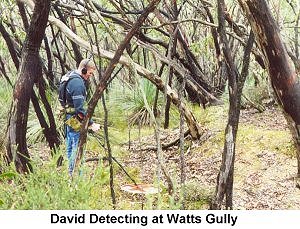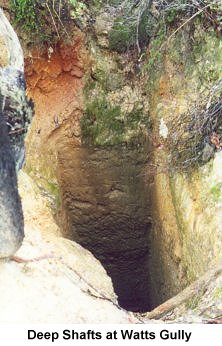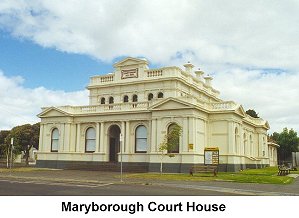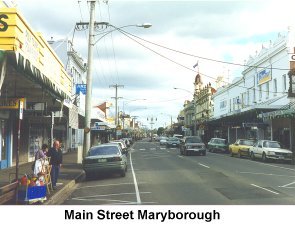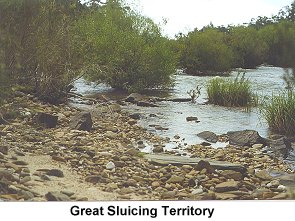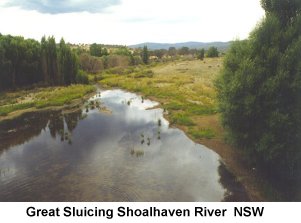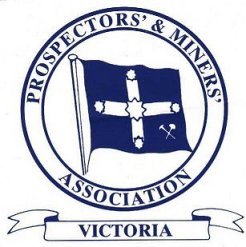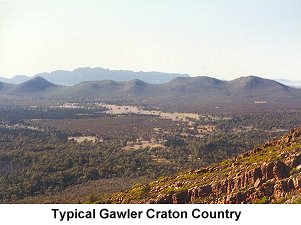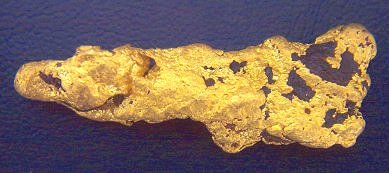
| October 2001 | ||||||||||||||||||||||||||||||||||||||||||||||||||||||||||||||||||||||||||||||||||||||||||||||||||||||||||||||||||||||||||||||||||||||||||||||||
|
||||||||||||||||||||||||||||||||||||||||||||||||||||||||||||||||||||||||||||||||||||||||||||||||||||||||||||||||||||||||||||||||||||||||||||||||
Contents
|
||||||||||||||||||||||||||||||||||||||||||||||||||||||||||||||||||||||||||||||||||||||||||||||||||||||||||||||||||||||||||||||||||||||||||||||||
1. EDITORIAL Gold Net Australia is proud to announce that the Gold Expo will again be held in 2002. The Ballarat Exhibition & Entertainment Centre - has again been booked for the Expo. The dates are the 16th & 17th March 2002.
Work began - just one week after the Expo concluded in March this year - and we can look forward to an
expanded and outstanding Exposition which will be bigger and better than last years event. Watch for further developments as we progress towards the 2002 event. Editor Email: [email protected]
All material in this magazine is copyright and may not be reproduced in any part or form whatsoever without written permission from the publisher.
|
||||||||||||||||||||||||||||||||||||||||||||||||||||||||||||||||||||||||||||||||||||||||||||||||||||||||||||||||||||||||||||||||||||||||||||||||
2. WALLOWING AT WATTS
 by Brad Williams
It was a dark and stormy night. Actually I seem to have heard that somewhere before, but it really was an incredibly stormy night. My son David had decided to try his hand at detecting and I was hell bent on sluicing the creek at Watts Gully, near Williamstown. I had charged the battery for the detector overnight and was all packed and ready when No 1 son arrived. He even made it early, which surprised me. Now explaining the workings of a Minelab 2200 to someone who had never used a detector before isn't easy in a 40-minute drive - and with a not so interested listener the task was not easy. By the time we arrived at Watts Gully, I had not quite got to how coils work. Never the less - I had been somewhat successful in creating enough interest for David to at least "have a go."
And wet enough it was - the torrent of water that was plummeting down the creek sure made it a tough task. So donning the rubber boots and grabbing a gold pan provided by my old mate Martin Marks, I ventured into the creek shovel in hand. Picking out a likely spot I shovelled a heap of good looking sand from the side of the creek into the pan and carefully starting the swirling process. Boy was it cold there. David just stood and looked at me - suggesting that I perhaps needed to take a good look at my intelligence quotient, but not in quite so polite words.
Ignoring the comments, I continued to freeze my fingers as I sluiced away.
At the end of the first pan full - I was stunned. There were lots of shiny bits gleaming away at me from the bottom the pan. And I mean lots.
I grinned from ear to ear and said, "Hey mate - take a look at that sport".
His reply was a little sobering, "Is that gold?" Those comments brought me back to earth somewhat - so I slipped the reading glasses on and took a closer look. Perhaps I should have done that before. There were lots of shiny things in that pan - but it wasn't gold. Is was hydrous silicate in mono-clinic crystalline form. Otherwise commonly known as mica. Well - back to the drawing board for me - so I tried again in that creek - right up and down almost the entire length over about 2 hours, with exactly the same results. As time wore on the weather closed in more and more and the rain started to bucket down again - just about lunchtime. I had planned a nice picnic lunch with a table set and chairs etc - but with rain pouring down we were relegated to sit in the car with steamed up windows and eat chicken legs and wings in our fingers - without all the trimmings. It was a 'blokes' lunch on the run - so to speak. After an hour or so - the rain suddenly stopped and the sun came shining through, and within minutes we were outside the car and David was getting the gear on to take the Minelab 2200 on a good run into the gullies at Watts that extend right up several steep slopes. Now the Watts Gully gold fields had a good share of alluvial - but the further up the slopes one goes, the deep mines become more evident, so clearly most of the gold up the slopes was from deep shafts. However gold is where you find it, and the Minelab 2200 with the UFO coil were a good combination for the day.
Just as I reached the top of the escarpment - David called me back down the hill. Unfortunately the attachment from the coil to the detector had come loose and the coil was swinging around like a pendulum. Fortunately I had some tape in my pocket so I was able to tape it up temporarily.
No sooner had we repaired that when the battery started to go. As we walked down the track the rain was getting heavier and heavier. The road was clay and I was slipping all over the place, stumbling up and down the hills along that track heading back to the car. Would the rain stop - No way. It just kept pouring down in torrents, until we were both drenched to the skin. To make our position worse - the creek we had to cross had swollen even further and crossing that with just boots on was going to be a "wet foot" experience, for sure. We both got very wet feet crossing that creek - but it didn't really matter - we were drenched anyway. We headed back to Adelaide very wet and with not a skerrick of the yellow stuff. The detector was a little sick - and we were both drenched to the skin. That hot shower when we got home was very welcome.
I have not given up on Watts Gully - but sluicing there is not something I will try again in a hurry - but detecting - I'll be back there for sure.
|
||||||||||||||||||||||||||||||||||||||||||||||||||||||||||||||||||||||||||||||||||||||||||||||||||||||||||||||||||||||||||||||||||||||||||||||||
|
||||||||||||||||||||||||||||||||||||||||||||||||||||||||||||||||||||||||||||||||||||||||||||||||||||||||||||||||||||||||||||||||||||||||||||||||
3. NUGGETS, NUGGETS AND MORE NUGGETS by Sue "Goldie" Reynolds Maryborough in Central Victoria, since the discovery of gold in Victoria has been an effervescent source of gold - with particularly large nuggets being the order of the day. For some reason this area continues to pour forth more than its fair share of gleaming yellow gold. The largest nugget recorded that came from Maryborough was recovered at Blackman's Lead in June 1855 and weighed 833 ounces - and was found at a depth of 5 feet. A further 537-ounce nugget was found at Blackman's lead, 6 feet below the surface in January 1858. Blackman's Lead again featured in 1854, when a 360 ounce nugget was found 34 feet below the surface.
In 1856, at White Hills, Maryborough, a 236-ounce nugget was unearthed at 12 feet. It was described as a solid lump of gold.
The Old Court House - Town Hall and Post Office - are an outstanding example of the architecture of the day, reflected the rich heritage of the era.
Of note in recent years is the enormous amount of large nuggets that Maryborough is still producing.
Within the last two years, an 86-ounce nugget, a 43-ounce nugget and a reputed 400-ounce plus nugget have been located in this area. Undoubtedly there have been many more large nuggets recovered from Maryborough that have not been disclosed. At the recent Gold Expo in Ballarat in March a large number of 40 ounce plus nuggets were displayed with a good percentage, reputed to have been sourced from Maryborough. I personally saw at least two over 40 ounces from this area.
South of the town the area has been particularly productive, with evidence of dozing in several areas. I have detected these dozed areas - with limited success, with a reasonable amount of small gold found. Small gold is abundant, and plenty of .5 to 3 gram pieces are not hard to find in this location. Well gold is always hard to find - but small gold is there if you care to concentrate on looking for it. But then gold is gold. To the west of the town along the train line that extends to the west are some great little areas - but I try and leave this area alone because of the prickly bushes that abound there. Years ago it would not have mattered - but today I treat this as a hobby - not a chore. I have no doubt that in the future Maryborough will continue to produce an abundance of large nuggets for a long time to come.
|
||||||||||||||||||||||||||||||||||||||||||||||||||||||||||||||||||||||||||||||||||||||||||||||||||||||||||||||||||||||||||||||||||||||||||||||||
|
||||||||||||||||||||||||||||||||||||||||||||||||||||||||||||||||||||||||||||||||||||||||||||||||||||||||||||||||||||||||||||||||||||||||||||||||
4. WHEN AND WHERE TO SLUICE by Laurelle Murphy Australia has some great sluicing sites. In fact many of the best are very close to capital cities, and are good producers of quality gold most of the time. Perhaps the best known areas to sluice are in the close proximity of Sydney. By close proximity - I am suggesting within a radius of say 150 km or 100 miles of Sydney. The many rivers and creeks in the Bathurst area are continually productive. Many of the watercourses in this area are highly auriferous, and consequently highly productive. This area has a multitude of rivers and creeks that are well known producers of gold and with a little research and background knowledge coupled with an understanding of sluicing techniques, positive results are almost guaranteed.
Perhaps the best area to explore in this region is the area just east of Bathurst. From The Turon at Sofala, and many of its tributaries, to Wattle Flat, Palmers Oakey, Meadows Flat, through to O'Connell and Oberon. The fabulous gold country through the Morton National Park should not be forgotten, but remembering that most of this ground is a National Park and is not accessible, care must be taken to ensure that the rivers and creeks accessed are not inside the National Park.
In the western areas of New South Wales - through the Young, Cowra, Forbes, and Parks area many opportunities exist to recover excellent gold from waterways. The only difficulty in this area is the lack of running water.
In the northern regions of New South Wales - many waterways are auriferous.
From Coffs Harbour to Bingara and to Tabulan, the waterways, although somewhat difficult to access are very productive sources of gold. To the south of New South Wales many auriferous areas abound - and although a lot of this gold is in nugget form many waterways hide a great deal of gold. From West Wyalong through to Eden great opportunities exist to recover gold through the many rivers and streams that abound throughout this region. South of the border, the terrain changes substantially. Access to many good waterways is difficult, however, many of the regions that are auriferous do produce excellent gold. From the Beechworth, Yackandandah, El Dorado area, south through the Great Dividing Range, excellent areas to exist to sluice. Perhaps the aforementioned area is one of the easiest to access.
However, again with some good detective work in the archives and through local historical data, many good areas can be accessed and good gold recovered. I am aware of many who sluice in this region successfully. 0 Perhaps the most overlooked area in Victoria is the Walhalla - Woods Point Sub-Province, which has enormous auriferous areas. From Jamieson in the north to Walhalla in the south the depth and breadth of gold throughout this area is exciting. However once again the topography is difficult, and many of the best areas are close to impossible to reach. Tasmania's Tamar region is an area of considerable significance. In the past this waterway and its tributaries produced excellent quantities of gold. Very few recognise this region as a quality region to recover gold, and consequently many excellent areas can be accessed with ease to recover gold.
There are of course other areas throughout Australia that provide excellent opportunities to recover gold by sluicing. However it should be recognised that sluicing in Australia is an underdone activity. Although it has a solid following in the area surrounding Sydney, where gold appears to be in abundance, in Victoria - the same could not be said. In any case Australia has an abundance of gold producing waterways that are just waiting for the dedicated to go and get.
Additionally we have excellent gold recovery equipment, and none more professional that M & D Marks, Super Sluice. If you do have an interest Martin Marks, the current Australasian Gold Panning Champion is always willing to give advice to prospective and interested enthusiasts.
Martin can be phoned in Sydney on (02) 9838 0397.
|
||||||||||||||||||||||||||||||||||||||||||||||||||||||||||||||||||||||||||||||||||||||||||||||||||||||||||||||||||||||||||||||||||||||||||||||||
|
||||||||||||||||||||||||||||||||||||||||||||||||||||||||||||||||||||||||||||||||||||||||||||||||||||||||||||||||||||||||||||||||||||||||||||||||
|
5. THE BOX IRON BARK FIGHT  by Craig Wilson The Box Iron Bark fight has just begun. If the EEC and politicians think that the prospecting fraternity will accept the bizarre recommendations in the final report of the EEC - they totally underestimate the heart, soul and commitment of this normally quiet group, who generally go about their recreational hobby in a quiet and respectful manner. It is rare in my experience, to find a prospector who doesn't understand and respect the environment in which he works. To enjoy the real forests is a wonderful experience, and one that very few politicians and for that matter "green" supporters ever experience.
Come to think of it - in all the years I have been out in the bush detecting - I don't think I have ever come across a member who I could identify as a "green" member.
To read in detail what has been taken from the prospecting and mining fraternity, in this final report by the EEC is a total injustice. There is no doubt about that.
The PMAV have led a strong campaign supporting our rights. They have worked tirelessly - none more so than Rita Bentley and the executive. Against immense odds, they have persisted in a consistant sensible stance against the more bizarre recommendations included in this report.
Sensible suggestions put forward by the PMAV have been overlooked - without explanation.
What can WE do to ensure that our rights are sensibly protected.
The suggested form is included below - along with a link to a single page prepared letter.
Dear (Insert Parliamentary member, See Below) As a prospector I am concerned that the proposals in the Environment Conservation Council�s Report on the Box Ironbark Region will cause further unnecessary limitations on my prospecting activities. I would like clarification of the following matters: Are you aware that the main economic benefit claimed by the ECC is a �non-use� benefit of $2 million per year? This is the �value� given to the warm and fuzzy feeling that the people of Victoria are supposed to get from just knowing that the parks and reserves exist � even if they never visit them. Are you aware that if the ECC�s proposals are adopted it will be at a huge social and economic cost, including many job losses, to the people of central Victoria? Are you satisfied that the ECC has considered forms of land management other than the �lock out� method of creating parks and reserves? The Regional Forest Agreement process created Special Management Zones to satisfy Government criteria � was any other management process considered by the ECC? Is the Government prepared to adequately fund the new parks and reserves, their establishment and upkeep, their promotion and care etc? Why are our current parks and reserves in such poor condition � as identified in the recently published Parks Victoria audit? Why can�t prospecting be permitted throughout the region, except in limited areas where it can be demonstrated that it is not appropriate? The consultant who prepared the economic and social assessment recommended that there be a review of current restrictions on prospecting. Can you ascertain why this was not adopted by the ECC in their recommendations? Are you satisfied that the ECC has provided proof that current land uses are not sustainable? Are you satisfied that the ECC has provided proof that parks and reserves enhance habitat or biodiversity? Has the ECC provided proof that bird numbers will increase when prospecting is banned in the new parks? Why are small-scale miners being hounded out of existence by the ECC even though they always rehabilitate their sites, never leave holes open and vegetation is always re-established? Do you believe that Government should pay adequate compensation to those who will lose economic opportunities if the recommendations are adopted? Are you sure that the ECC has followed fair and proper processes during its investigation? Is there adequate science behind the recommendations? Why hasn�t the public been given the opportunity to adequately comment on the revised recommendations? I look forward to receiving your response to the above questions. Yours sincerely
Below is the list of politicians who should be contacted regarding this matter.
|
||||||||||||||||||||||||||||||||||||||||||||||||||||||||||||||||||||||||||||||||||||||||||||||||||||||||||||||||||||||||||||||||||||||||||||||||
|
||||||||||||||||||||||||||||||||||||||||||||||||||||||||||||||||||||||||||||||||||||||||||||||||||||||||||||||||||||||||||||||||||||||||||||||||
6. A NEW MINE FOR DOMINION by Brad Williams
Dominion Mining Limited (ASX: DOM) has given formal approval to proceed with financing and development of the Challenger Gold Project in South Australia. Gold production is expected to begin in the second half of 2002.
Dominion Mining has given the green light to spend $17.1 million on the development.
Dominion's Managing Director, Mr Peter Alexander, said the Company would immediately proceed to finalise a debt funding package for the Project. This process is expected to be completed within a month. The South Australian Government, through Primary Industries of South Australia (PIRSA), has invested over $20 million to date on aeromagnetic surveys and regional exploration in the Gawler Craton to kick-start the region's exploration industry.
The first stage will operate for approximately two years. At that time Dominion will complete a detailed assessment of the deep extension of the Challenger orebody. The total capital cost for the open cut development is $17.1 million, which will be funded by a combination of debt and internal cash resources. Approximately 65% of the capital cost ($11 million) is expected to be funded by a project debt facility. Dominion's current cash balance is $15.2 million. Cash operating costs for the open cut mine are estimated at AUD$278/ounce. An interim gold hedge position of approximately 40% of the open cut reserve (10% of the total resource) at an average spot price of AUD$580/ounce has been put in place during September in order to secure the viability of the project and take advantage of the recent strength in the gold price. The project, which is located 740 kilometres north-west of Adelaide, is expected to employ up to 70 people once in full production. Pending successful finalisation of a debt finance package, Dominion expects to commence siteworks in December, with first gold production expected by Quarter 3 in 2002. All relevant statutory and other approvals for the project have been completed, including native title agreements, the granting of the Mining Lease by PIRSA, and federal environmental consent. Dominion has also secured the approval of the Department of Defence, given that the Challenger Project is located within the Woomera prohibited area. Dominion's Chairman, Mr Peter Joseph, said: "I would like to pay tribute to all parties involved with this development, particularly the South Australian Government and the Native Title claimant groups. The process has been collaborative and professional with all parties wishing the Project to proceed expeditiously. Dominion has an excellent track record in working with aboriginal communities in remote areas and with managing projects in an environmentally sustainable manner." "We look forward to establishing a significant new mining operation for South Australia. Challenger represents one of many anomalies within our 10,000 sq km tenement holding on the Gawler Craton. We are confident that Dominion will continue to produce gold from this region for many years to come," he added. This begins the first of many projects that are projected to commence this decade within the Gawler Craton. It is indeed a welcome addition to a burgeoning industry in this promising region of untapped resources within South Australia. Clearly the positive contribution and phenomenal success of Western Mining in the north of this region has clearly laid down a solid ground work that will assist in opening up this area for the benefit of us all.
|
||||||||||||||||||||||||||||||||||||||||||||||||||||||||||||||||||||||||||||||||||||||||||||||||||||||||||||||||||||||||||||||||||||||||||||||||
|
||||||||||||||||||||||||||||||||||||||||||||||||||||||||||||||||||||||||||||||||||||||||||||||||||||||||||||||||||||||||||||||||||||||||||||||||
7. FLECKS ! - Glints from here and there
|
||||||||||||||||||||||||||||||||||||||||||||||||||||||||||||||||||||||||||||||||||||||||||||||||||||||||||||||||||||||||||||||||||||||||||||||||
|
The Australian Gold and Prospector's Expo will again be held at the Ballarat Exhibition and Entertainment Centre, Western Highway, Ballarat on the 16 -17 March 2002. With the outstanding success of the last event - planning began only two weeks after the event concluded. The event next year will correlate closely with the March event - as it was so successful. A full debrief was undertaken at the comclusion of the event - and a number of items were discussed and improvements will be made for the 2002 event. The event venue is now under new management - and some alterations have already been made to the interior of the venue - that have enhanced the internal appearance. Forums have been discussed at length - however available personnel to undertake these forums is a problem at the moment - and I can say that although these have been considered at length - it is unlikely that forums will be a part of the event next year.
Through the medium of Events Ballarat and Beyond and with their support - we have applied for advertising funding through a government grant. Effective advertising is always an expensive exercise and we are hopeful that the grant available through the Country Victoria Tourism Council will be successful.
Entry to the event will rise to $8.00 per adult with children remaining free. This rise was necessary to ensure the continuation of the event.
Almost all exhibitors who attended last year are expected to attend again this year - no doubt due to the very successful event this year.
|
||||||||||||||||||||||||||||||||||||||||||||||||||||||||||||||||||||||||||||||||||||||||||||||||||||||||||||||||||||||||||||||||||||||||||||||||
|
||||||||||||||||||||||||||||||||||||||||||||||||||||||||||||||||||||||||||||||||||||||||||||||||||||||||||||||||||||||||||||||||||||||||||||||||
8. STRIKES Recent Finds
|
||||||||||||||||||||||||||||||||||||||||||||||||||||||||||||||||||||||||||||||||||||||||||||||||||||||||||||||||||||||||||||||||||||||||||||||||
|
||||||||||||||||||||||||||||||||||||||||||||||||||||||||||||||||||||||||||||||||||||||||||||||||||||||||||||||||||||||||||||||||||||||||||||||||
|
9. THE NEW LODE - Next Month's Issue
|
||||||||||||||||||||||||||||||||||||||||||||||||||||||||||||||||||||||||||||||||||||||||||||||||||||||||||||||||||||||||||||||||||||||||||||||||
|
||||||||||||||||||||||||||||||||||||||||||||||||||||||||||||||||||||||||||||||||||||||||||||||||||||||||||||||||||||||||||||||||||||||||||||||||
